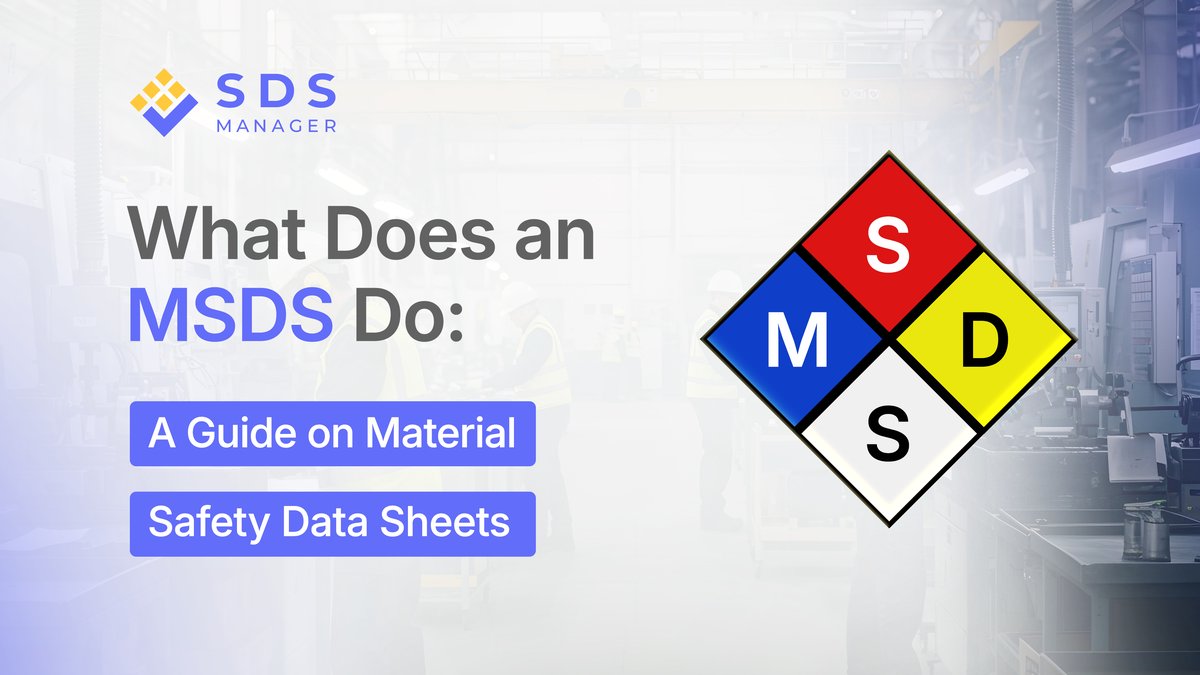

Material Safety Data Sheets (MSDS) are documents created to share important information about chemical safety with both employers and workers. Their main role is to help anyone working with chemicals understand the risks involved and the steps needed to stay safe.
Structure of an MSDS
Material Safety Data Sheets (MSDS) act as a clear guide for employees, contractors, and emergency responders, such as paramedics and firefighters. They explain what a chemical is, how it behaves, how to use and store it safely, and what to do in case of spills, accidents, or exposure. All this information is organized into specific sections to make it easy to find and use.
There is no single worldwide standard for how an MSDS must be structured. Depending on the country or the company that issues it, an MSDS can have anywhere from 8 to 16 sections. In Australia, regulations required MSDSs to include all 16 standard sections. Below is a summary of what these sections cover:
| Section | Description |
|---|---|
| Identification of the Material and Supplier | Provides the product name, recommended uses, and manufacturer or supplier details, including emergency contact information. |
| Hazards Identification | Clearly outlines the main health, safety, and environmental hazards, including warning symbols and important risk phrases to help you recognize the dangers. |
| Composition/Information on Ingredients | Lists all hazardous ingredients, their chemical names, and concentrations, making it easy to see what’s inside and what might cause harm. |
| First Aid Measures | Gives step-by-step instructions for treating exposure through inhalation, skin or eye contact, or swallowing, so you can respond quickly and effectively. |
| Fire Fighting Measures | Details suitable extinguishing agents, special protective gear for firefighters, and any specific hazards that may appear if the chemical catches fire. |
| Accidental Release Measures | Explains how to safely contain and clean up spills or leaks, including recommended personal protective equipment and ways to prevent environmental contamination. |
| Handling and Storage | Offers practical advice on safe handling to avoid accidents, and gives clear storage guidelines to prevent dangerous reactions or deterioration. |
| Exposure Controls/Personal Protection | Recommends ways to limit exposure, such as ventilation or process controls, and specifies personal protective equipment like gloves, goggles, or masks. |
| Physical and Chemical Properties | Lists key facts such as appearance, odor, boiling and melting points, flash point, and solubility, helping you recognize the chemical and understand its behavior. |
| Stability and Reactivity | Describes how stable the chemical is under normal conditions, what can cause it to react, and any dangerous by-products that might form. |
| Toxicological Information | Explains possible health effects from short-term or long-term exposure, including symptoms, routes of entry, and whether the chemical is known to cause cancer or other diseases. |
| Ecological Information | Summarizes the chemical’s impact on the environment, such as toxicity to aquatic life, persistence, and potential for bioaccumulation. |
| Disposal Considerations | Provides safe and responsible disposal methods for the chemical and its containers, including any special handling or legal requirements. |
| Transport Information | Covers classification for transport, proper shipping names, hazard labels, and any special precautions needed during transit by road, rail, sea, or air. |
| Regulatory Information | Lists relevant Australian laws, regulations, and standards that apply to the chemical, helping ensure legal compliance in handling and use. |
| Other Information | Includes extra details like the date of preparation or last revision, references for further information, and any other helpful notes. |
What Does MSDS Do in Practice?
A Material Safety Data Sheet (MSDS) is a valuable document that supports workplace safety and compliance in several important ways:
- Functions as a Training Aid: MSDSs are used during safety training to help workers understand the specific hazards of chemicals and the precautions they need to take. They show employees how to find and use safety information with confidence.
- Acts as an Emergency Guide: If there is a spill or someone is exposed to a chemical, the MSDS offers fast access to instructions for first aid, firefighting, and cleaning up. This quick guidance helps prevent harm and keeps situations under control.
- Ensures Compliance Support: In industries with strict regulations, keeping a full set of MSDSs is required by law. Inspectors may check these documents during audits to make sure companies are following safety rules.
- Acts as a Risk Assessment Tool: Environmental, health, and safety (EHS) teams rely on MSDSs to evaluate chemical risks, decide on the right protective equipment, and set up safe work practices.
MSDS vs. SDS: Why the Difference Matters
Unlike most other countries, MSDSs in Australia also followed the 16-section format as later globally standardized and adopted by SDSs, under the Global Harmonized System (GHS).
Ensuring a safe workplace environment
While the core intent behind MSDSs and SDSs were identical: providing timely critical chemical hazard information to stakeholders dealing with hazardous chemicals, however, the lack of standardization created challenges to smooth international trade, with the requirement of multiple versions of MSDSs for the same material across various countries or industries and regulating workplace safety more complex. The global shift to SDS allows organizations to smoothly ensure workplace safety and compliance.